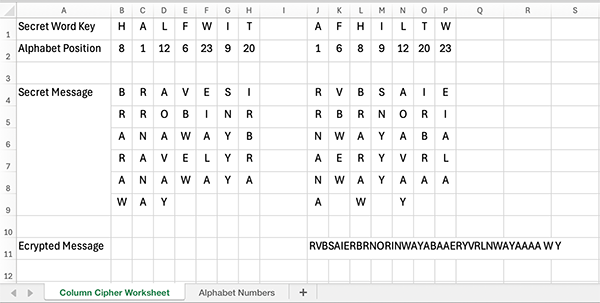Happy Wednesday and thanks again for opening and reading this email. This week I have a mix of STEM stories. There’s an underwater bike park and interesting NASA climate change websites. Links to articles about the intersection of technology and religion. A column cipher project to create secret messages. And I answer the question, what do you call a group of owls, like the ones above? Plus what the earth looks like from Saturn. Hope you enjoy these stories as much as I had fun researching and writing them.
Column Ciphers
For the next few Wednesday emails, I want to feature secret codes, aka ciphers. They’re a fun way to learn a little math and sometimes history. Plus they make good projects to do with kids, maybe on a family game night. Or a small project for students who finish classwork early.
Let’s start with a column cipher to encode a secret message. Column ciphers are a secret code that use a small bit of math. You start with a secret word that could be any word. Then you transpose or mix up characters in the words in your plaintext message based on your secret word. Transposition codes date back to the ancient Spartans in the 5th century BCE.
For this project, you’ll need:
- A pen or pencil
- Any old piece of paper.
- A fun secret word about 4-8 letters long with no repeating letters. Penguins uses the letter n twice and doesn’t work, sadly. Penguins could be fun. Your secret word is the key to decipher your encoded message.
- And a long-ish plaintext secret message to encode.
Probably the hardest part is coming up with a secret word key because you can’t repeat letters. Here’s a few word ideas that I found online that might trigger (can’t use that word) a few giggles (ditto):
From A to Z, how about beanpole, boing, bonkers, crows, egads, frogman, gasbag, gizmo, halfwit, harumph, hokum, hyena, ignoramus, ironclad, jalopy, jetsam, kaput, king, lingo, moniker, mufti, outfox, pachyderm, pseudonym, quirky, rhino, schlep, toady, vertigo, widget, wonky, wordplay, yokel, zaftig, zebra, or zonked. If you’re looking for a short secret word key, how about fez, owl, or kid?
With your word picked out, come up with a secret message. If your secret word key is 5 letters long, a secret message of at least 15 or 20 characters works great.
Now on your piece of paper write out the secret word key. Under each letter, write the number of the letter from 1 to 26 that the letter appears in the alphabet. Then write your message character by character under the secret word key. With no spaces. And go to the next line when the character in your message reaches the last character of your secret word key.
To create your secret code, next reorder each column of characters. Using the number under each secret word character, order your columns from left to right.
This is the message to send. Minus the secret word and the numbers under each character in the word. To decipher your message, the recipient writes down the secret word key. Then writes the number of the letter from 1 to 26 that the letter appears in the alphabet. Then writes the column of characters under the appropriate key character.
Here’s what it looks like in an Excel spreadsheet I created. I’ve linked the spreadsheet below if you want to play with it too.

In this spreadsheet, my secret word key is HALFWIT. The secret message is from Monty Python and the Holy Grail, “Brave Sir Robin ran away, Bravely ran away away!” And the encrypted secret message result is RVBSAIERBRNORINWAYABAAERYVRLNWAYAAAA W Y, with spaces between at the end between the letters A, W, and Y.
How to adapt this secret code technique? You might use the secret word Penguin if you use a and b to distinguish between the first and second n in the word? You could go really crazy (because penguins might be crazy) and put the a and b last. But the recipient of your message would need to know these facts AND your secret word key. Otherwise, your fun message will come out as gibberish. That’s not good.
The Column and Caesar Ciphers: Ancient Cryptography
https://www.probabilisticworld.com/caesar-column-ciphers-ancient-cryptography/
Transposition cipher
https://en.wikipedia.org/wiki/Transposition_cipher
https://en.wikipedia.org/wiki/Transposition_cipher#Columnar_transposition
The Story of Cryptography: History
https://ghostvolt.com/articles/cryptography_history.html
Cryptanalysis
https://en.wikipedia.org/wiki/Cryptanalysis
My Column Cipher Excel Spreadsheet
column-cipher-worksheet-30STEMLinks
NASA Climate Time Machine
NASA’s has two websites with useful climate data visualization tools. Their Earth Observatory website is like a time machine that lets you see data over time. For example, snowfall, airborne aerosols, vegetation, and sea surface temperatures. Their Climate Time Machine has similar data but displayed differently. The sea level page, for example, shows the North pole sea ice from 1979 to 2024 (spoiler: there’s a lot less ice).
You also might check out their Climate Change page which includes current metrics. Their Vital Signs include Carbon Dioxide, Global Temperature, and Methane levels.
Climate Time Machine
https://climate.nasa.gov/interactives/climate-time-machine/?intent=021
NASA Earth Observatory – Global Maps
https://earthobservatory.nasa.gov/global-maps
Climate Change
https://science.nasa.gov/climate-change/
Park Your Bike Underwater?
Awhile back, in my social media feeds, I saw a story about underwater bike parking. I love contrarian stories. This story, however, turns out to be a clever city (Amsterdam) repurposing space near their main train station that happens to be under a canal nearby. The result is highly useful and beautiful bit of engineering. It’s also a solution to a very real problem: apparently lots of people ride bikes and drop them anywhere and everywhere. Parking your bike also is free for the first 24 hours.
In researching this story, I discovered underwater cycling is a thing. But it requires scuba gear. And that’s kind of hard to use above ground, out of water. It’s easier to use your bike and, if you’re in Amsterdam, park underwater.
Amsterdam’s under water bicycle parking garage
Underwater bike garage solves Amsterdam station’s storage headache
Underwater cycling
https://en.wikipedia.org/wiki/Underwater_cycling
Digital Divinity
If you don’t know, Rest of World is an online publication that covers technology outside of what’s considered the Western world. That’s outside the US, Canada, and Europe. They’ve published an interesting series about the intersection of religion and technology. In the visual style of a medieval manuscript which is (cough, cough) European. 🙂 However, their articles cover topics rarely covered elsewhere. Including, in this case, religion and technology. Their web page design for the series also is extremely beautiful. Worth looking at with a laptop or desktop computer.
Here’s how they describe their goals with this series:
“Technology has transformed how we spend, study, live, eat — even how we sleep. And for the 6.75 billion people around the world who consider themselves religious, technology is also changing their faith. How people worship, pray, and commune with the divine is transforming from Seoul to Lagos.
Earlier this year, Rest of World set out to document the myriad of ways that religious believers are using new technologies in their daily practices. This illustrated storybook represents a broad spectrum of themes and trends playing out across a number of religions and countries that include Hindu temples made by 3D printers to priests that dance on TikTok. They speak to the unraveling tensions of our time as people turn to technology to simplify their lives, search for answers, or find platform-born fame.
These short stories offer insight into trends that range from the unique and unexpected to the artificial and financial. Just as influence, power, and need are shaping the world, they are also moving ancient faiths. This push and pull between old and new, between the ancient and modern, is now happening at lightning speed.”
Digital Divinity – Rest of World
https://restofworld.org/series/digital-divinity/
Stressed young people in China are tapping digital wooden fish
https://restofworld.org/2024/divinity-apps-wooden-fish/
Behold, the world’s first 3D-printed temple
https://restofworld.org/2024/divinity-unexpected-3d-temples/
PETA is building robot elephants for Hindu temples
https://restofworld.org/2024/divinity-unexpected-robot-elephants/
“Almost everything will work again if you unplug it for a few minutes, including you.” — Anne Lamott
How do you call a group of owls?
One interesting thing about science are the names given to groups of animals. Scientists don’t say there’s a bunch of rhinoceroses, for example. They say there’s a crash of rhinos. Or a cackle of hyenas. Seriously. Many of these names came from The Book of Saint Albans, an essay about hunting published in 1486. They’re based on observing animals. Hyenas laugh, for example. And rhinos definitely crash through things when they move.
The group name for owls has a different origin. In ancient Greece, people thought owls were wise. When owls gather together, they’re called a parliament. Owls however don’t get together to build roads or buildings. Humans do gather in parliaments to make public policy. And it’s a good thing when parliaments are wise, isn’t it?
These group names are officially called collective nouns. There’s also different names used for animals based on gender and age. A young bird is a chick, for example, while a female bird is a hen.
List of animal names
https://en.wikipedia.org/wiki/List_of_animal_names
A Parliament of Owls and a Murder of Crows: How Groups of Birds Got Their Names, with Wondrous Vintage Illustrations by Brian Wildsmith
https://www.themarginalian.org/2024/01/04/brian-wildsmith-birds-company-terms/
The Book of Saint Albans
https://en.wikipedia.org/wiki/Book_of_Saint_Albans
Names for Groups of Animals
https://www.almanac.com/names-groups-animals
This Week
Our Sunday email this week will have fun often offbeat links about … Look for the email this Sunday.


